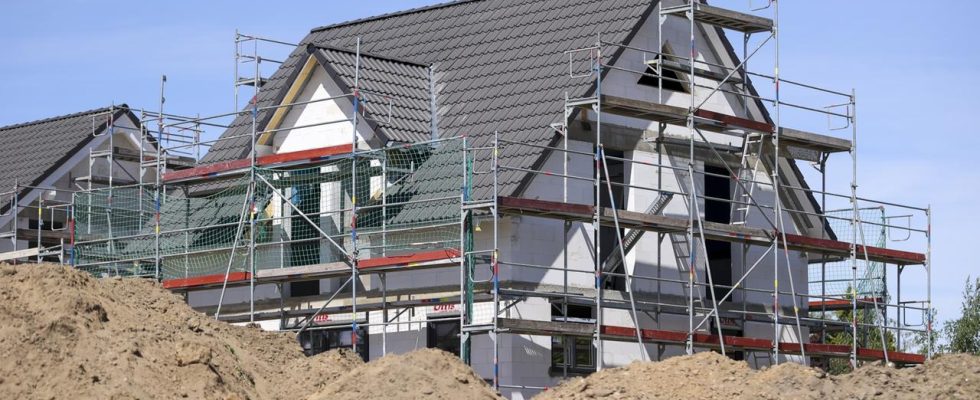The Federal Building Ministry has launched a new funding program for families with low and medium incomes: They are to be encouraged to build a house with cheap loans. But who is this suitable for?
Building is currently more expensive than it has been for a long time. Even if you find a reasonably cheap building plot, have enough equity capital and can keep the construction costs within limits, you have to reckon with a loan of half a million euros for a family house. Almost half of this can be done via the new subsidy program of the Ministry of Construction. A maximum of 240,000 euros will then be financed via a loan from the state-owned KfW bank – at a reduced interest rate of 1.25 percent.
For the rest, a loan at standard market conditions is required, the interest rate is currently around four percent. Interest and repayment added together result in a monthly charge of around 2000 euros. That’s a lot of money for an example family with one child who can earn a maximum of 60,000 euros gross per year. The family should have little more than 4,000 euros a month net, of which everything has to be paid for.
Banks have to play along
But even if the example family dares to put about half of their monthly income into paying off the building loan, another hurdle has to be overcome: the bank has to play along. The money for the discounted loan officially comes from the state development bank KfW, but the transaction is handled by your own house bank. She has to evaluate the creditworthiness of a customer, i.e. assess whether he can make the monthly payments. The bank makes the decision on the KfW loan and the additional loan according to its own criteria.
Hermann-Josef Tenhagen, editor-in-chief of Finanztip, fears that many banks will oppose the family and not grant them a larger loan. In his estimation, a higher household income is necessary to be able to seriously finance a property: at least 100,000 euros. That is a more solid basis for a real estate loan, says Tenhagen in an interview with the ARD Capital Studio.
Criticism of the program also comes from the opposition in the Bundestag: “Young families can’t afford that,” says CDU MP Ulrich Lange. “This program is going to cause a lot of frustration, a lot of disappointment.”
At most new buildings in the country
A decisive point will be the place where the new house is to be built. Building plots in metropolitan areas are known to be affordable for very few. “Top residential areas ten kilometers from Frankfurt am Main will not work,” says financial expert Tenhagen. Families with low and medium incomes who want to take advantage of the new subsidy program will probably have to look for land in rural areas.
Ideally, says Tenhagen, the family would have inherited a building site from their parents or grandparents and could keep the costs for a new building low. For example, by craftsmen from the circle of friends or acquaintances helping out. This is an ideal picture that probably applies to very few families. Tenhagen also points out that the family would have to come to terms with life in the country. He calculates: “If two cars are needed to get to the job that is maybe 40 kilometers away, it can easily cost 1,000 euros a month. Then it can be difficult to service the loan.”
Conditions of the grant program
Maximum household income of 60,000 euros
The limit increases by 10,000 euros for each additional child
Discounted KfW loan with an interest rate of 1.25 percent
Maximum loan amount of 240,000 euros
New construction must be climate-friendly according to the EH40 criterion
“Less than a drop in the bucket”
The construction industry also assumes that the target group of the new funding program is rather small. Oliver Wittke, general manager of the Central Real Estate Committee ZIA, calls the property promotion only a “little program” that cannot even begin to solve the problem of the lack of living space. The ZIA has calculated that only 2,500 new homes will be created in Germany as a result of the new home ownership promotion.
And for that, the funds from the program would have to be drawn in full. In view of the at least 400,000 missing apartments, the program is less than a drop in the bucket, Wittke says in an interview with the ARD Capital Studio. The construction industry recognizes the efforts of the federal government – but a solution to the problem is not getting any closer.
Height efficiency standards are mandatory
In addition, the Ministry of Building only wants to promote climate-friendly new buildings. They must meet the EH40 criterion. This means that the houses may only consume 40 percent of the energy that is required for older comparable buildings. These houses need particularly well insulated walls and windows so that as little energy as possible is lost to the outside. They are therefore significantly more expensive to build than conventional houses:
Experts speak of an additional 300 euros per square meter. Usually an investment that builders with big budgets consider. Construction Minister Klara Geywitz, of all people, doubts whether EH40 makes sense and is sustainable at all, because a lot of CO2 is released during the production of the insulating materials.
Nevertheless, EH40 has become the condition for a new building to use the new program – and it comes from Geywitz. Your ministry has announced that it will draw up a first summary of how property promotion has started in six weeks. It is hard to imagine that families with low or medium incomes in particular can and want to afford the highest standard of efficiency for new buildings.

